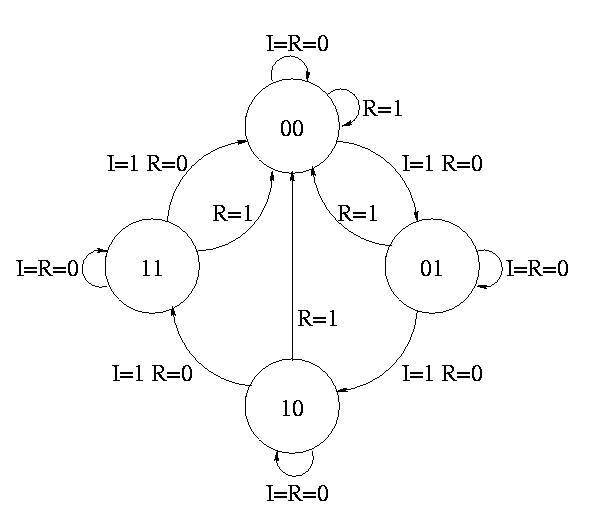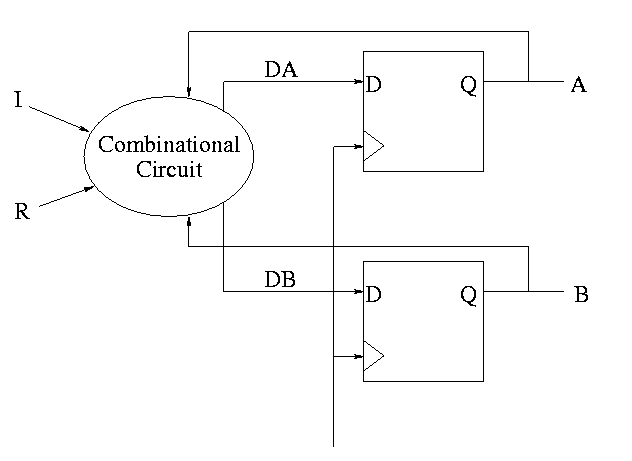======== START LECTURE #8
========
How about a two bit counter.
- State diagram has 4 states 00, 01, 10, 11 and transitions from one
to another
- The circuit diagram has 2 D flops


To determine the combinationatorial circuit we could preceed as before
Current Next ||
A B I R A B || DA DB
------------------++------
This would work but we can instead think about how a counter works and
see that.
DA = R'(A XOR I)
DB = R'(B XOR AI)
Homework: 23
B.6: Finite State Machines
Skipped
B.7 Timing Methodologies
Skipped
Chapter 1
Homework:
READ chapter 1. Do 1.1 -- 1.26 (really one matching question)
Do 1.27 to 1.44 (another matching question),
1.45 (and do 7200 RPM and 10,000 RPM),
1.46, 1.50
Chapter 3
Homework:
Read sections 3.1 3.2 3.3
3.4 Representing instructions in the Computer (MIPS)
Register file
- We just learned how to build this
- 32 Registers each 32 bits
- Register 0 is always 0 when read and stores to register 0 are ignored
Homework:
3.2
R-type instruction (R for register)
op rs rt rd shamt funct
6 5 5 5 5 6
The fields are quite consistent
- op is the opcode
- rs,rt are source operands
- rd is destination
- shamt is the shift amount
- funct is used for op=0 to distinguish alu ops
- alu is arithmetic and logic unit
- add/sub/and/or/not etc.
Example: add $1,$2,$3
- Machine format: 0--2--3--1--0--21
- op=0, alu op
- funct=21 specifies add
- reg1 <-- reg2 + reg3
- the regs can be the same (doubles the value in the reg)
- Do sub by just changing the funct
- If regs are the same, clears the register
I-type (why I?)
op rs rt address
6 5 5 16
- rs is a source reg
- rt is the destination reg
- Transfers to/from memory, normally in words (32-bits)
- But the machine is byte addressible!
- Then how come have load/store word instead of byte?
- Ans: It has load/store byte as well, but we don't cover it.
- What if the address is not a multiple of 4:
- Ans: An error (MIPS requires aligned accesses).
lw/sw $1,addr($2)
- machine format is: op 2 1 addr
- $1 <-- Mem[$2+addr]
$1 --> Mem[$2+addr]
RISC-like properties of the MIPS architecture
- Instructions of the same length
- Field sizes of R-type and I-type correspond.
- The type (R-type, I-type, etc.) is determined by the opcode
- Note that rs is the ref to memory for both load and store
- These properties will prove helpful when we construct a MIPS processor.
Branching instruction
slt (set less-then)
- R-type
- Slt $3,$8,$2
- reg3 <-- (if reg8 < reg2 then 1 else 0)
- Like other R-types: read 2nd and 3rd reg, write 1st
beq and bne (branch (not) equal)
- I-type
- beq $1,$2,L
- if reg1=reg2 then goto L
- bne $1,$2,L
- if reg1!=reg2 then goto L
blt (branch if less than)
- I-type
- blt $5,$8,L
- if reg5 < reg8 then goto L
- *** WRONG ***
- There is no blt instruction.
- Instead use
stl $1,$5,$8
bne $1,$0,L
ble (branch if less than or equal)
- There is no ``ble $5,$8,L'' instruction.
- Note that $5<=$8 <==> NOT ($8<$5)
- Hence we test for $8<$5 and branch if false
stl $1,$8,$5
beq $1,$0,L
bgt (branch if greater than>
- There is no ``bgt $5,$8,L'' instruction.
- Note that $5>$8 <==> $8<$5
- Hence we test for $8<$5 and branch if true
stl $1,$8,$5
bne $1,$0,L
bge (branch if greater than or equal>
- There is no ``bge $5,$8,L'' instruction.
- Note that $5>=$8 <==> NOT ($5<$8)
- Hence we test for $5<$8 and branch if
stl $1,$5,$8
beq $1,$0,L
Note:
Please do not make the mistake of thinking that
stl $1,$5,$8
beq $1,$0,L
is the same as
stl $1,$8,$5
bne $1,$0,L
The negation of X < Y is not Y < X
Homework:
3.12-3.17
J-type instructions (J for jump)
op address
6 26
j (jump)
- J type
- Range is 2^26 words = 1/4 GB
jr (jump register)
- R type, but only one register
- Will it be one of the source registers or the destination register?
- Ans: This will be obvious when we construct the processor
jal (jump and link)
- Used for subroutine calls
- J type
- return address is stored in register 31
I type instructions (revisited)
- The I is for immediate
- These instructions have an immediate third operand,
i.e., the third operand is contained in the instruction itself.
- This means the operand itself and not just its address or register
number are contained in the instruction
addi (add immediate)
addi $1,$2,100
Why is there no subi?
Ans: Make the immediate operand negative.
slti (set less-than immediate)
slti $1,$2,50


